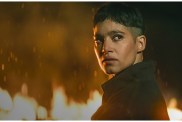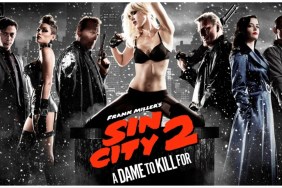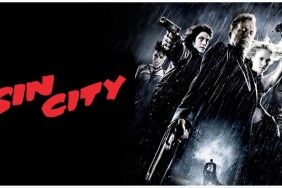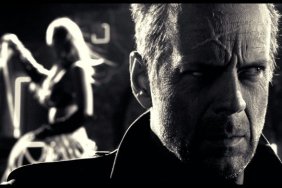Cast:
Mickey Rourke as Marv
Jessica Alba as Nancy
Josh Brolin as Dwight
Joseph Gordon-Levitt as Johnny
Rosario Dawson as Gail
Bruce Willis as Hartigan
Eva Green as Ava
Powers Boothe as Senator Roark
Dennis Haysbert as Manute
Ray Liotta as Joey
Jamie Chung as Miho
Julia Garner as Marcie
Christopher Meloni as Mort
Jeremy Piven as Bob
Christopher Lloyd as Kroenig
Jaime King as Goldie / Wendy
Juno Temple as Sally
Stacy Keach
Marton Csokas as Damien Lord
Jude Ciccolella as Lt. Liebowitz
Lady Gaga as Bertha
Directed by Robert Rodriguez and Frank Miller
Story:
More stories from Frank Miller’s Sin City including some familiar characters and some new ones:
Johnny (Joseph Gordon-Levitt) has always been lucky and he never loses, but when he takes a lot of money from Senator Roark (Powers Boothe) in a poker game, he gets a lot more than he bargained for.
Against his better judgment, Dwight McCarthy (Josh Brolin) ends up back in the clutches of his ex Ava (Eva Green), now married with much darker secret than he’s aware.
Meanwhile, stripper Nancy (Jessica Alba) still wants revenge for the death of John Hartigan (Bruce Willis) so she enlists Marv (Mickey Rourke) to help her.
Analysis:
“A Dame to Kill For” is as much a prequel to the original “Sin City” as it is a sequel to it, broken up into four distinct stories, the main portion of the movie being an adaptation of the graphic novel from where it got its title.
This section has Josh Brolin replacing Clive Owen from the original movie as he plays the down-on-his-luck Sin City resident Dwight, who finds himself drawn back to his sultry ex Ava (Eva Green) who seems to have ulterior motives for wanting Dwight back in her life. Despite being the one story taken directly from Miller’s comics that brings back many of the characters from the first movie, it’s also the section with the least returning actors. While Rosario Dawson returns as Gail, the leader of Old Town’s vigilante prostitutes, to help Dwight when he gets into trouble again, Jamie Chung and Dennis Haysbert do a fairly indiscernible job making the roles of Miho and Manute their own. (A number of plot points make it obvious this story takes place before “The Big Fat Kill” from the first movie.)
The brand-new story written specifically for the move involves Joseph Gordon-Levitt–a natural fit within Miller’s world–as a charming gambler whose luck takes him to a backroom poker game where he’s warned not to win too much. Sure enough, he walks out with all the money of Power Boothe’s Senator Roark, who gets even more screentime in the sequel with connections to a number of the stories, and finds himself being chased by thugs with his “good luck charm” Marcie (Julia Garner) by his side.
Miller’s hard-boiled noir writing is the film’s driving force, often taking the dialogue and first-person narration verbatim from the comics when applicable with the stories taking place during different time periods. For instance, Jessica Alba’s Nancy in Gordon-Levitt’s story has obviously been worn down by her environment and what she’s had to endure over the years, her joy of dancing for men long gone as she only seeks one thing: revenge. Bruce Willis’ Hartigan is merely a phantom who appears in mirrors to drive Nancy to join with Mickey Rourke’s Marv, brought back through the wonders of flashback, to follow through with that plan.
We’ve seen this type of non-linear anthology storytelling before, most notably in Rodriguez pal Quentin Tarantino’s “Pulp Fiction,” but that coincidence may lay partially in the fact that both Tarantino and Miller were influenced by some of the same source material.
For the second time this year, it’s Eva Green’s presence that saves another sequel to a Frank Miller adaptation after “300: Rise of an Empire” earlier this year, maybe because Ava is a character with a lot of different sides and Green’s daring enough to expose more of herself than we’ve seen before. Even so, one would never think they could tire of Eva Green’s naked breasts, yet even they wear out their welcome.
The film does an incredible job maintaining the distinctive look of Miller’s comic artwork, although some of the techniques used in the first movie have been perfected by others since the original “Sin City,” including Zack Snyder with “300.” As much as the sequel was clearly made with 3D in mind, certain aspects like Mickey Rourke’s Marv make-up sometimes detract from the overall look since the 3D makes it look even more fake.
Although predominantly in black and white like the comics, the decisions made by Rodriguez and Miller as far as what should be in color–usually it’s the film’s comely actresses, either in part or full–really helps them to stand out against the film’s limited palette.
Granted, “A Dame to Kill For” does come across as somewhat one-note in terms of the storytelling, and by the 50th time you’ve seen someone shot in the neck with an arrow or beheaded with white neon blood flying everywhere, the violence has become somewhat oppressive in its repetition.
The Bottom Line:
A relatively worthy follow-up to what was a breakthrough movie for its time loses some luster from the time passed while still delivering the originality of Miller’s visuals and Rodriguez’s flair for action.










